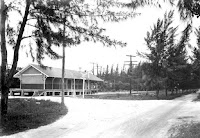 |
| General store or restaurant in Hallandale 1921 Florida State Archives |
By Jane Feehan
Hallandale, a mostly rural community from the late 1800s
until the 1960s, was first laid out in 1898. Henry Flagler extended his Florida
East Coast railway from St. Augustine to Miami after a series of damaging Florida freezes from 1894-1896 left South Florida relatively
unscathed.
Flagler’s business model, as with other railways across the
nation at the time, included developing and populating communities along the
line. Rev. Bengt Magnus Halland of Burlington, Iowa was recruited by Flagler’s
company to promote settlement in an area south of Fort Lauderdale. Halland, a
Swedish immigrant, had already helped develop communities along rail lines in the
Midwest.
 |
| Florida East Coast Rail Depot in Hallandale 1922 Florida State Archives |
The settlement was first referred to as Halland, but the U.S. Postal Service, according to some accounts, probably added the “dale” to distinguish it from a town named Holland on Florida’s west coast. History claims the town was named after the Reverend’s son, Luther Halland. Swedes from the North and among those immigrating from Sweden were encouraged to settle in Halland’s community (ethnic settlements along Florida’s rail lines were a common occurrence).
Flyers or announcements in Swedish described farming opportunities awaiting them in the settlement— a place where “10,000 acres of good lands will raise profitable crops within a two-mile radius of Hallandale.” It was reported the land would support a wide variety of crops including tomatoes, corn, Irish potatoes, sweet potatoes, lettuce, celery, cabbage and strawberries ... and maybe pineapples. In 1912, the railway in Hallandale was claimed to be one of the heaviest shipping points along the [rail] line.
By 1921, the small town was home to 500 residents, four general stores, a school and packing house. The Flava Fruit Company, which owned groves 12 miles south in Miami and acreage in Hallandale set out to develop the town.
They promoted the sale of 115 lots along Dixie Highway known as Flava Park, a sub-division of the community. They also planned a wide boulevard from the ocean to the East Coast Canal. In 1921, the Flava Inn opened featuring a Sunday fried chicken dinner for $1.50.
They sold their subdivision in 1923 and continued similar activities in Miami. Development of this farming town did not capture the same attention nor dynamic as did Miami, Fort Lauderdale, Boca Raton and Palm Beach.
 |
| Gulfstream park Florida State Archives |
Hollywood annexed Hallandale in 1926. Residents petitioned to secede from Hollywood and were granted to do so in 1927. By that year, 1,500 called Hallandale home. The town reincorporated in 1947 as the City of Hallandale (eighth municipality of Broward County) and transitioned to the name Hallandale Beach in 1999. Shedding its rural character, Hallandale Beach is now lined with shoulder-to-shoulder multi-million-dollar beachside condominiums. Today, one of the hottest real estate markets in South Florida, Hallandale is also the home of Gulfstream Park.
Copyright © 2022 All rights reserved. Jane Feehan
For more on Hallandale Beach, see: https://www.cohb.org/ and https://hallandalebeachchamber.org/
The city also offers some interesting mob and gambling history of the 1940s; For more, use search box for Meyer Lansky, Colonial Inn.
Miami News, May 17, 1912
Miami Herald, March 3, 1921
Miami Herald, April 20, 1921
Miami Herald, July 7, 1921
Fort Lauderdale News, Jan. 17, 1926
Miami News, Feb. 19, 1927
Miami News, March 6, 1927
Miami News, May 15, 1927
Florida Journal, Broward Legacy, Vol. 20: Adams, William
R
Tags: Hallandale history, Broward County cities
